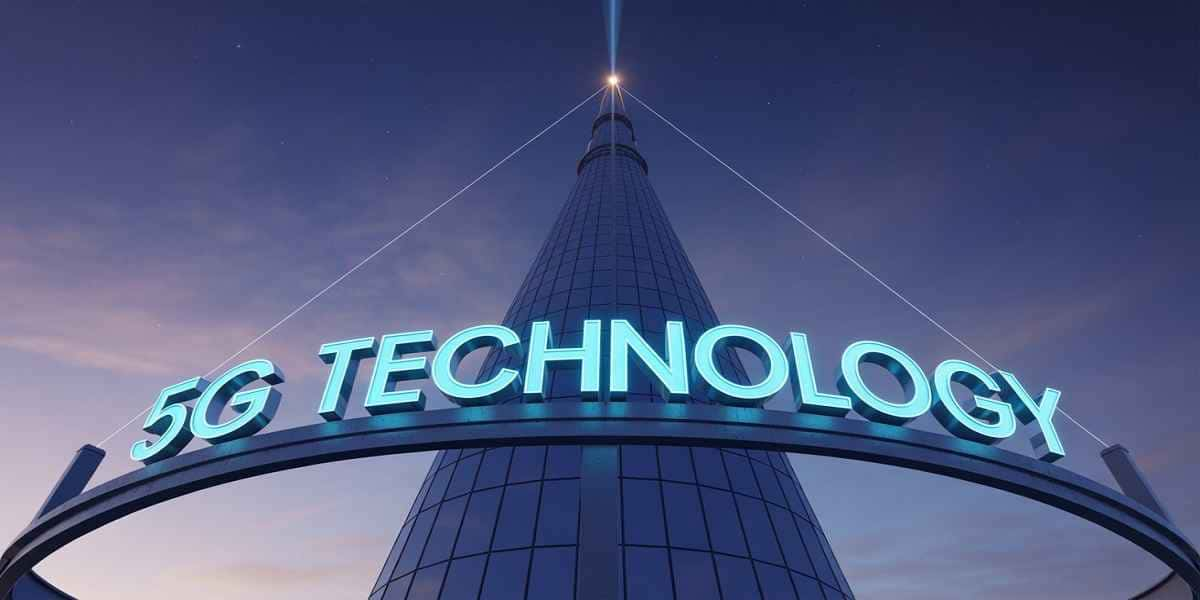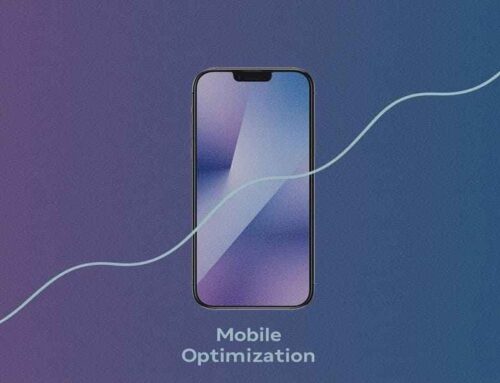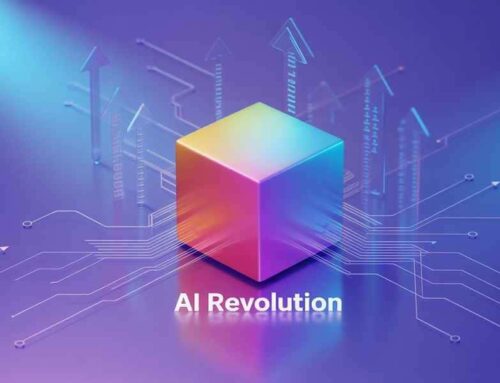
How is 5G Technology truly powering effortless real-time business growth?
You, the modern business leader, the innovative entrepreneur, the forward-thinking strategist, are you ready to revolutionize your operations? Are you prepared to transcend the limitations of traditional connectivity and step into an era of unprecedented speed, efficiency and growth?
The future isn’t just coming; it’s here and it’s powered by 5G Technology.
What is 5G Technology?
At its core, 5G Technology is the fifth generation of cellular mobile communication. It’s not just a faster version of 4G; it’s a foundational shift. Think of it as a leap from a winding country road to a multi-lane, hyper-speed highway designed for the digital age.
This revolutionary technology is engineered to deliver significantly higher speeds, ultra-low latency and massive capacity. This means more devices can connect simultaneously without performance degradation.
This means data moves in near real-time. This means a paradigm shift for how businesses operate and innovate. Do you grasp the sheer potential of this transformation?
The Speed You Need, The Responsiveness You Demand
Imagine downloading an entire movie in seconds. Now, translate that speed to your business operations. With peak theoretical speeds reaching up to 10 gigabits per second (GBPS), 5G Technology is a game-changer for data-intensive tasks.
Consider large file transfers, complex data analytics and real-time streaming of high-definition content. All of these become seamless. Gone are the days of buffering, lag and frustrating delays.
But speed is only half the story. The real magic of 5G Technology lies in its ultra-low latency. Latency is the delay before a transfer of data begins following an instruction.
While 4G boasts latency in the tens of milliseconds, 5G aims for a mere one millisecond. What does this mean for your business? It means instantaneous communication between devices, systems and people.
Think about remote control of machinery, surgical precision in remote operations and self-driving vehicles reacting in real-time to their surroundings. This responsiveness opens up entirely new possibilities for automation, safety and efficiency. Are you envisioning the impact on your operational agility?
Massive Capacity: Connecting Everything, Everywhere
The Internet of Things (IoT) is no longer a futuristic concept; it’s a present reality. From smart factories to connected cities, an ever-increasing number of devices are coming online. 4G networks, while robust, can struggle with the sheer volume of these connections.
This is where 5G Technology shines. Its massive capacity allows for millions of devices per square kilometer to connect simultaneously without compromising performance.
This unparalleled capacity fuels the growth of true smart environments. Consider a retail store with hundreds of sensors tracking inventory, customer movement and temperature. Or a sprawling manufacturing plant with thousands of interconnected machines providing real-time data on production lines.
5G Technology makes this level of pervasive connectivity not just feasible but effortless. It enables a denser, more intelligent network where every device has a voice, contributing to a holistic view of your operations. How will this pervasive connectivity transform your data collection and decision-making processes?
Transforming Industries: A Sector-by-Sector Revolution
The impact of 5G Technology isn’t confined to a single industry; it’s a wave of innovation sweeping across all sectors.
Manufacturing and Industry 4.0: For manufacturers, 5G Technology is the bedrock of Industry 4.0. It enables truly smart factories where machines communicate autonomously, predictive maintenance prevents costly downtime and robots collaborate seamlessly with human workers.
Real-time data from sensors on assembly lines allows for immediate adjustments, leading to higher quality products and reduced waste. Augmented reality (AR) and virtual reality (VR) powered by 5G can provide workers with immersive training and real-time operational guidance.
“The only constant in life is change,” as Heraclitus famously said and 5G is the accelerator of this change in manufacturing. Are you ready for a factory that thinks for itself?
Healthcare and Telemedicine: In healthcare, 5G Technology is a lifeline. Telemedicine becomes truly viable with ultra-low latency, allowing doctors to conduct high-quality virtual consultations and even remote surgeries with incredible precision.
Real-time monitoring of patients’ vital signs from remote locations becomes commonplace. Smart hospitals can leverage 5G for asset tracking, inventory management and even powering advanced diagnostic tools. The speed and reliability of 5G ensure that critical medical data is transmitted instantly and securely, empowering better patient outcomes. Consider the implications for rural healthcare access.
What new possibilities does this open for patient care and medical innovation?
Retail and Customer Experience: For retailers, 5G Technology offers a wealth of opportunities to enhance the customer experience and optimize operations. Think about augmented reality shopping experiences where customers can virtually try on clothes or visualize furniture in their homes.
In-store analytics become more sophisticated, providing real-time insights into customer behavior and traffic patterns. Smart shelves can automatically reorder stock and seamless mobile payments become the norm.
This translates to a more personalized, efficient and engaging shopping journey for your customers.
Are you envisioning a truly intelligent retail environment?
Logistics and Supply Chain Management: The complexities of modern supply chains demand real-time visibility and agile responses. 5G Technology provides precisely that.
It enables real-time tracking of goods from origin to destination, allowing for immediate adjustments to routes or schedules based on unforeseen circumstances. Autonomous vehicles and drones, powered by 5G, can revolutionize last-mile delivery.
Predictive analytics, fueled by high-volume data from connected sensors, can optimize inventory levels and prevent bottlenecks. This leads to more efficient, resilient and cost-effective supply chains.
How will 5G transform your ability to deliver?
Smart Cities and Urban Development: The vision of a smart city hinges on pervasive connectivity. 5G Technology is the nervous system for intelligent urban environments. It connects smart streetlights that adjust based on traffic and weather, smart waste management systems that optimize collection routes and intelligent traffic management systems that reduce congestion.
Public safety is enhanced through connected surveillance and rapid communication for emergency services. This creates more livable, sustainable and efficient urban spaces.
“The future belongs to those who believe in the beauty of their dreams,” Eleanor Roosevelt once remarked.
Is your city dreaming big with 5G?
Agriculture and Smart Farming: Even traditional industries like agriculture are being revolutionized by 5G Technology. Smart farms can deploy sensors to monitor soil conditions, crop health and livestock in real-time.
Drones equipped with 5G can provide precise data for irrigation and fertilization, leading to higher yields and reduced resource consumption. Automated farming machinery can operate with greater precision and efficiency.
This empowers farmers to make data-driven decisions, leading to more sustainable and productive agricultural practices.
What new efficiencies can 5G bring to your farm?
The Ecosystem of Effortless Real-Time Growth
The power of 5G Technology extends beyond individual applications; it fosters an entire ecosystem of innovation.
Edge Computing Synergy: 5G’s ultra-low latency perfectly complements edge computing. Edge computing brings data processing closer to the source of data generation, reducing the need to send all data to a centralized cloud.
When combined with 5G, this allows for immediate analysis and action, crucial for real-time applications like autonomous vehicles and industrial automation. Decisions can be made at the edge, milliseconds matter and 5G delivers those milliseconds.
Are you thinking about how edge computing and 5G can unlock new levels of responsiveness for your operations?
AI and Machine Learning Amplification: The vast amounts of data generated by 5G-connected devices become the fuel for artificial intelligence (AI) and machine learning (ML) algorithms. With more real-time, granular data, AI models can become more accurate, learn faster and provide deeper insights.
From predictive analytics to personalized recommendations, 5G accelerates the capabilities of AI, allowing businesses to make smarter, more informed decisions in real-time. It’s the ultimate feedback loop: 5G provides the data, AI processes it and businesses gain actionable intelligence.
How will this synergy elevate your data-driven strategies?
Enhanced Security: While often associated with speed, 5G Technology also brings enhanced security features. Its architecture provides improved encryption and network slicing capabilities, allowing for dedicated, isolated network slices for critical applications.
This means sensitive business data and operations can have their own secure, high-performance lanes, minimizing the risk of interference or cyber threats. In an increasingly connected world, robust security is paramount and 5G helps build that secure foundation.
Are your current security measures ready for the connected future?
New Business Models and Revenue Streams: The capabilities of 5G Technology aren’t just about optimizing existing processes; they enable entirely new business models and revenue streams.
Think about personalized, on-demand services delivered with unprecedented speed. Consider subscription models for IoT-powered solutions that were previously impossible due to connectivity limitations. The ability to connect massive numbers of devices and deliver real-time data opens up fertile ground for innovative products and services.
What new markets can 5G help you tap into?
Navigating the Roadblocks: The Challenges of 5G Technology Adoption
While the potential of 5G Technology is undeniably immense, it’s crucial for any forward-thinking business to acknowledge and understand the practical challenges that come with its widespread adoption.
No revolutionary technology arrives without its own set of hurdles.
Are you prepared to navigate these complexities to fully unlock 5G’s power?
High Infrastructure Costs and Deployment Complexity: The transition to 5G isn’t a simple software upgrade; it demands substantial investment in new infrastructure. Unlike previous generations that relied on larger, fewer cell towers, 5G, particularly in its higher frequency bands (mmWave), requires a denser network of smaller cells placed closer together.
This leads to significantly higher costs for network operators and, by extension, can impact the cost of services for businesses. Building this extensive network, including fiber optic backbones to support the increased data flow, is a massive undertaking.
Are you considering the initial capital expenditure required to fully leverage 5G in your specific business context?
Limited Coverage and Uneven Rollout: Despite rapid deployment, 5G Technology coverage is still not ubiquitous. It tends to be concentrated in urban and densely populated areas first, leaving rural or remote regions with slower or non-existent 5G access. This uneven rollout can create a digital divide, impacting businesses operating in less connected areas.
Furthermore, high-frequency 5G signals, while fast, can be easily blocked by physical obstacles like buildings, trees and even heavy rain, potentially leading to inconsistent indoor or obstructed coverage.
How will you address potential coverage gaps for your distributed operations or remote workforce?
Increased Energy Consumption and Environmental Concerns: While 5G networks are designed to be more energy-efficient per unit of data transmitted than 4G, the sheer increase in data traffic and the proliferation of connected devices will likely lead to a net increase in overall energy consumption.
The densification of network infrastructure, with many more small cells and base stations, also contributes to higher power demands. This raises concerns about the environmental footprint and operational costs related to energy.
Have you considered the long-term energy implications for your business and its sustainability goals?
Device Compatibility and Upgrade Cycles: To fully capitalize on 5G Technology, businesses and consumers need 5G-compatible devices. Older equipment, from smartphones to industrial sensors, may not support the new network capabilities, necessitating costly upgrades.
This can be a significant barrier for businesses with large existing equipment inventories and can slow down the adoption of 5G-powered solutions.
Is your organization ready for the potential investment in new hardware?
Expanded Cybersecurity Attack Surface: While 5G introduces advanced security features like network slicing, the vast increase in connected devices (Especially IoT) and the complexity of the network architecture also inherently expand the attack surface for cyber threats. More endpoints mean more potential vulnerabilities.
New software-defined network elements can introduce their own security challenges if not properly managed. Businesses must adopt even more robust and proactive cybersecurity measures to protect their operations and sensitive data in a 5G environment.
Are your cybersecurity protocols ready to tackle this expanded landscape of potential threats?
Integration with Legacy Systems: Many businesses operate with a mix of new and older technologies. Integrating 5G-powered solutions with existing legacy systems can be complex, time-consuming and costly.
Ensuring seamless interoperability between different generations of technology and diverse hardware and software platforms requires careful planning and execution.
How will you bridge the gap between your current infrastructure and the future of 5G?
Regulatory and Spectrum Challenges: Governments worldwide are still navigating the complexities of 5G Technology spectrum allocation and regulation. Delays or inconsistencies in policy can hinder deployment and limit the full potential of 5G.
This ongoing regulatory landscape can add uncertainty for businesses planning their 5G strategies.
Paving the Way Forward: Strategies for Seamless 5G Adoption
Understanding these challenges isn’t about diminishing the value of 5G Technology, but rather about approaching its adoption with a clear, realistic strategy. Addressing these potential roadblocks proactively will position your business to truly harness the transformative power of 5G for effortless real-time growth.
Have you thoroughly assessed these potential obstacles for your specific business?
Infrastructure Investment: Deploying 5G requires significant investment in new infrastructure, including more dense cell tower placements and fiber optic backbones. This is an ongoing process, but the long-term benefits far outweigh the initial outlay.
Government support and private sector collaboration are crucial for accelerating this build-out.
Are you considering the long-term ROI of investing in 5G-ready infrastructure?
Spectrum Availability and Regulation: The availability of sufficient spectrum is vital for 5G performance. Governments worldwide are actively working to allocate and regulate spectrum bands to facilitate widespread 5G adoption.
Clear and consistent regulatory frameworks are essential for industry growth.
Device Compatibility and Ecosystem Maturity: As 5G networks expand, so too does the availability of 5G-compatible devices and a mature ecosystem of applications and services.
This is a rapidly evolving landscape, with new devices and solutions continually emerging to leverage the full potential of 5G Technology.
Are your devices and systems ready for the 5G era?
Cybersecurity Preparedness: While 5G offers enhanced security features, the increased connectivity also expands the attack surface. Businesses must prioritize robust cybersecurity strategies, including network segmentation, endpoint protection and continuous monitoring, to safeguard their 5G-powered operations.
Vigilance is key in the hyper-connected world.
The Future is Here: Are You Ready to Grow?
The phrase “5G Technology” represents more than just a technological upgrade; it signifies a fundamental shift in how businesses operate, innovate and grow. It’s about powering effortless real-time business growth by enabling unprecedented speed, ultra-low latency and massive connectivity.
It’s about creating intelligent, responsive and efficient operations across every sector. From the factory floor to the doctor’s office, from the retail store to the agricultural field, 5G is the backbone of the next industrial revolution.
As Bill Gates famously said, “The first rule of any technology used in a business is that automation applied to an efficient operation will magnify the efficiency. The second is that automation applied to an inefficient operation will magnify the inefficiency.”
5G Technology provides the perfect platform to magnify efficiency and drive unprecedented growth for businesses that are ready to embrace its potential. It’s time to move beyond the limitations of the past and step into a future where real-time operations are not just a possibility, but a standard.
Are you prepared to seize this opportunity?
Don’t let your competitors leave you behind. Explore how 5G Technology can transform your business. Contact us today to discuss a tailored strategy for harnessing the power of 5G and achieving effortless real-time business growth.
The future of your business is connected, instantaneous and waiting for you.
FAQs
Q1: What is 5G Technology?
A1: 5G Technology is the fifth generation of cellular mobile communication, offering significantly higher speeds, ultra-low latency and massive capacity compared to previous generations like 4G. It’s a foundational shift in connectivity, designed for real-time data transfer and pervasive device connection.
Q2: How does 5G Technology contribute to faster business operations?
A2: 5G Technology offers peak theoretical speeds up to 10 gigabits per second (GBPS), enabling rapid transfer of large files, faster data analytics and seamless real-time streaming. This speed significantly reduces buffering and delays in data-intensive tasks.
Q3: What is “Ultra-Low Latency” in the context of 5G Technology and why is it important for businesses?
A3: Ultra-low latency refers to the minimal delay (As low as one millisecond) between an instruction and the start of data transfer. This is crucial for businesses as it enables instantaneous communication for applications like remote control of machinery, precise remote operations and self-driving vehicles, enhancing automation and responsiveness.
Q4: How does 5G Technology support the Internet of Things (IoT)?
A4: 5G Technology provides massive capacity, allowing millions of devices per square kilometer to connect simultaneously without performance degradation. This is essential for the widespread deployment of IoT devices in smart factories, cities and other environments, enabling pervasive connectivity and comprehensive data collection.
Q5: Which industries are most impacted by 5G Technology?
A5: 5G Technology is transforming numerous industries, including manufacturing (Industry 4.0), healthcare (Telemedicine, Remote Monitoring), retail (AR shopping, In-store analytics), logistics and supply chain management (Real-time tracking, Autonomous delivery), smart cities (Intelligent Infrastructure) and agriculture (Smart farming, Precise data for crops).
Q6: How does 5G Technology enhance manufacturing processes?
A6: In manufacturing, 5G Technology enables smart factories with autonomous machine communication, predictive maintenance, seamless robot-human collaboration and real-time data from assembly line sensors. It also supports AR/VR for immersive training and operational guidance.
Q7: Can 5G Technology improve healthcare services?
A7: Yes, 5G Technology is a game-changer for healthcare. It makes high-quality telemedicine viable, supports precise remote surgeries, allows real-time monitoring of patients’ vital signs and powers advanced diagnostic tools, leading to better patient outcomes and increased access to care.
Q8: What is the synergy between 5G Technology and edge computing?
A8: 5G’s ultra-low latency perfectly complements edge computing by allowing data processing to occur closer to the data source. This enables immediate analysis and action, crucial for real-time applications where milliseconds matter, such as autonomous systems and industrial automation.
Q9: How does 5G Technology benefit Artificial Intelligence (AI) and Machine Learning (ML)?
A9: 5G Technology generates vast amounts of real-time, granular data, which serves as critical fuel for AI and ML algorithms. This enables AI models to become more accurate, learn faster and provide deeper insights for predictive analytics and smarter decision-making.
Q10: What are the main challenges in the widespread adoption of 5G Technology?
A10: Key challenges include significant infrastructure investment (Dense cell tower placement, Fiber backbones), sufficient spectrum availability and clear regulation, ongoing development of 5G-compatible devices and a mature ecosystem and maintaining robust cybersecurity preparedness for the expanded attack surface.
Q11: Does 5G Technology improve cybersecurity?
A11: Yes, 5G Technology offers enhanced security features, including improved encryption and network slicing capabilities. This allows for dedicated, isolated network slices for critical applications, minimizing interference and cyber threats to sensitive business data and operations.
Q12: How can 5G Technology lead to new business models?
A12: By enabling unprecedented speed, massive connectivity and real-time data delivery, 5G Technology facilitates the creation of new business models. This includes personalized, on-demand services, subscription models for IoT-powered solutions and tapping into new markets previously constrained by connectivity limitations.
Q13: Why is investing in 5G-ready infrastructure important for businesses?
A13: Investing in 5G-ready infrastructure is crucial for businesses to fully leverage the benefits of 5G Technology. It allows them to implement advanced applications, optimize operations and stay competitive in a rapidly evolving digital landscape, offering a strong long-term return on investment.
Q14: Is 5G Technology just a faster version of 4G?
A14: No, 5G Technology is not just a faster 4G. It represents a foundational shift with distinct architectural differences, designed for much lower latency, higher capacity and the ability to connect a much broader range of devices for various real-time applications.
Q15: What is the first step a business should take to embrace 5G Technology?
A15: The first step is to assess your current operations and identify areas where enhanced speed, low latency or massive connectivity could provide significant benefits. Then, consider consulting with experts to develop a tailored strategy for integrating 5G Technology into your infrastructure and processes.














